Nik Sharma: ‘Cooking techniques have foundations in science’ | Food
Around four years ago, when he was working as a food photographer at a San Francisco-based meal delivery startup, Nik Sharma’s bosses delicately informed him that they were unhappy with his work. The problem? Well, his images were far, far too good. “The photos I was taking looked better than what people were getting delivered,” remembers Sharma with a laugh. “Customer expectations didn’t match what showed up. So I was told to tone down the quality of my photos and make them more realistic, which was a very bizarre thing to be told.”
It’s a story that confirms what devoted fans of this Mumbai-born, California-based cook and food writer have known for some time. Sharma – as evidenced by the tactile, painterly self-taken photographs that tend to accompany his recipes – has an innate visual understanding of culinary desirability. Sunset-yellow mango pudding appears sprinkled with pistachios; honey swirls onto figs in glistening strands; brown hands scatter flour in moody, Caravaggio lighting. Whether through his acclaimed blog, A Brown Table, or in Season – his debut cookbook from 2018 – the 40-year-old’s signature is food that unites earthy, cross-cultural abundance with uncommon good looks. He has, to put it another way, a feeder’s heart and an aesthete’s eye.
Now, however, his second recipe collection is out to explore the brains underpinning the beauty. Drawing on Sharma’s former career as a molecular biologist, The Flavor Equation deploys science to expand our notion of deliciousness – breaking it down into categories such as “emotion”, “mouthfeel” and “sight” – so that we can more effectively harness it in our cooking. “Even when I write about flavour I still tend to think about [it as] just aroma and taste,” he says. “But flavour is so many things. Texture, nostalgia; it’s a real multidimensional component.”
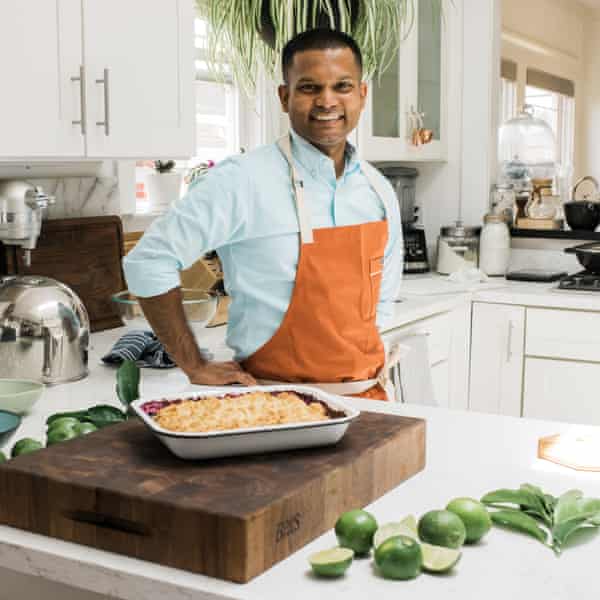
In practice, this thinking yields a book thick with illustrative diagrams, thoughtful deconstructions of the key pillars of flavour (including the five main tastes plus “fieriness” and “richness”), further reflections on Sharma’s mixed Indian heritage (his Hindu father is from Uttar Pradesh while his Roman Catholic mother is from Goa) and polyglot dishes that range from fried eggs with masala hash browns to buns filled with Portuguese chouriço sausage. In many ways it feels like a media-savvy splicing of Blumenthalian molecular gastronomy and the core philosophy of Samin Nosrat’s hit Salt, Fat, Acid, Heat. However, for Sharma, this pivot to science comes from a wholly organic place.
“Even though I left my scientific career a while back, that process of thinking hasn’t gone away,” says Sharma, chatting to me on a video call from the new Los Angeles home he and his husband moved into midway thr
ough lockdown. “I still go back to science papers to try to figure out why something is or isn’t working in the kitchen. So I wanted to write a book that was founded in the principles of science but that also felt approachable and practical.”
Hitting on this concept meant Sharma was free to figuratively don his lab coat for some rigorous experimentation in the kitchen. For instance, his gunpowder oven fries were perfected only after 28 different variations, and a textural eureka moment inspired, strangely enough, by the way citric acid is used in blood collection tubes. Elsewhere, attempts to explore how bitterness and sweetness counterbalance each other led to a pared-back idea for roasted fruits with coffee miso tahini. “I knew the science concept might be perceived as tough,” he notes. “So I wanted the recipes to feel more simple.”
Mostly, though, The Flavor Equation seeks to show that science in food is not all about gels, liquid nitrogen ice-cream and reverse spherification. “A lot of the cooking techniques that have been passed down through generations have foundations in science,” he says. “A vinaigrette is an emulsion at the end of the day. In Indian cooking they use a technique called tadka, where oil is heated and used as a solvent to extract essential oils from spices. There’s so much knowledge embedded in that technique.”
In this light, what Sharma is doing is making a case for the sophistication of things that home cooks do without a second thought. And highlighting the interconnectedness of what goes on at domestic cookers whether they are in Memphis or Mumbai. “Science happens in every kitchen, not just in the west,” he says. Now, his new book is out to make all our gastronomic experiments that bit more informed, impactful and, yes, maybe even a little more beautiful.
Roast chicken thighs and vegetables (pictured above)
A quick, flavourful chicken recipe with minimal effort. If you have time to marinate the chicken overnight, the flavour will benefit. Use an umami-flavoured salt to give this a whole new dimension of taste.
-
Worcestershire sauce acts as the savoury booster for the marinade that seasons the chicken.
-
The fat in the chicken is released during roasting and renders, adding a second component of flavouring to the vegetables in the pan.
-
Garlic, ginger, peppercorns and fresh chillies provide the “heat” molecules that act via chemesthesis.
Serves 4
For the chicken
chicken thighs 4 (total weight about 910g), bone in and skin left on
For the marinade
garlic 2 cloves, peeled
fresh ginger 2.5cm piece, peeled
white vinegar 2 tbsp
Worcestershire sauce 2 tbsp
extra virgin olive oil 2 tbsp
fine sea salt 1 tsp
black peppercorns ½ tsp
For the roasted vegetables
new potatoes 455g
mushrooms 230g, sliced
fresh or frozen peas 120g
extra virgin olive oil 1 tbsp
coarsely ground black pepper ½ tsp
fine sea salt
For the garnish
chives 2 tbsp, chopped
fresh green or red chilli 1, such as bird’s eye, thinly sliced
To prepare the chicken, dry the thighs with clean paper towels and place them in a large resealable bag.
To prepare the marinade, blend the garlic, ginger, vinegar, Worcestershire sauce, olive oil, salt and peppercorns on high speed for a few seconds until combined. Pour the marinade over the chicken, seal the bag, shake to coat and let marinate in the refrigerator for 2 hours, preferably overnight.
When ready to cook, set the bag with the chicken on the kitchen counter to reach room temperature, about 15 minutes.
Preheat the oven to 180C fan/gas mark 6.
To prepare the vegetables, toss the potatoes, mushrooms and peas in a large bowl with the olive oil and pepper, and season with salt. Spread the vegetables out in a large baking pan or roasting dish.
Remove the chicken from the bag and arrange the thighs, skin side up, over the vegetables. Pour any leftover marinade over the chicken thighs. Roast in the oven until the skin on the thighs is browned and crispy and the potatoes are soft and tender, 55 to 60 minutes. The chicken is ready when the internal temperature reaches 74C on an instant-read thermometer. Remove the pan from the oven and let sit for 5 minutes.
Garnish with the chives and chillies and serve.
Couscous with sesame-roasted carrots and feta
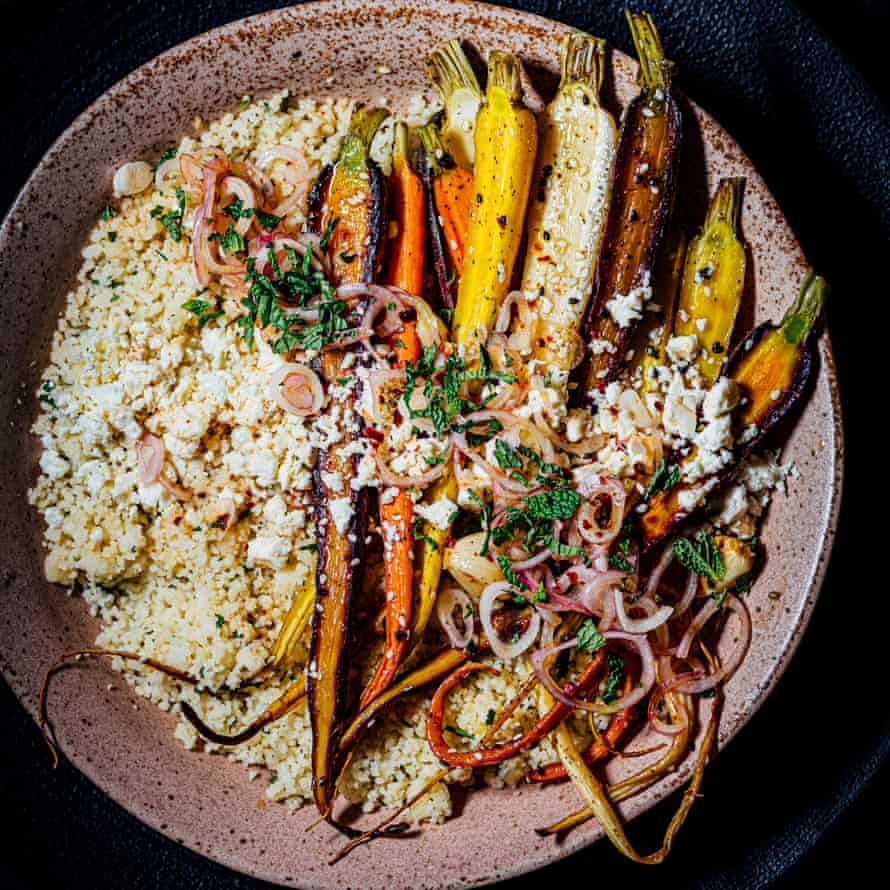
While filming a documentary for PBS in Oakland, California, my friend Jessica Jones (who produced the video) brought in a delicious couscous salad studded with roasted carrots and a bunch of fresh green herbs. It ranks as one of the most flavourful meals I’ve eaten. I might be a little biased because I think Jessica is absolutely wonderful. This couscous dish, inspired by Jess’s couscous, is also simple yet elegant.
-
Observe how vinegar affects the perception of salt in the shallot and sesame oil dressing. Acids increase the perception of saltiness, and you will end up using less salt than you would otherwise.
-
The shallot is cut thinly enough to pickle quickly when submerged in the acid in the vinegar. Notice how the pinkish-red anthocyanin pigments in the shallots turn a little more intense once they’re in the vinegar. The low pH helps intensify the colour.
Serves 4 as a side
For the couscous
carrots 455g, peeled and cut in half lengthways
garlic 8 cloves, peeled
extra virgin olive oil 3 tbsp
black sesame seeds 1 tsp
white sesame seeds 1 tsp
red chilli flakes 1 tsp, such as Aleppo, Maras or Urfa
fine sea salt
ground black pepper ½ tsp
low-sodium chicken stock 240ml, or water
bay leaves 2
couscous 135 g
coriander or flatleaf parsley 2 tbsp, chopped
feta 30g, crumbled
mint 2 tbsp, chopped
For the dressing
rice wine vinegar 60ml
toasted sesame oil 2 tbsp
maple syrup 1 tbsp, or 2 tsp honey
red chilli flakes ½ tsp, such as Aleppo, Maras or Urfa
fine sea salt
shallot 1 (60g), thinly sliced
To prepare the couscous, preheat the oven to 200C fan/gas mark 7.
Place the carrots in a roasting pan or baking sheet with 4 of the garlic cloves. Add 1 tablespoon of the olive oil, the black and white sesame seeds, and the red chilli flakes and rub with your fingers to coat the carrots and garlic. Season with salt and the black pepper. Roast for 25 to 30 minutes, until the carrots are crispy on the outside and thoroughly cooked and tender on the inside. Watch carefully to prevent the garlic from burning; it should be just slightly roasted and charred. Remove the cloves with a pair of kitchen tongs if they’re cooking too quickly.
Meanwhile, place the stock and the remaining 2 tablespoons of olive oil in a medium saucepan over medium-high heat. Smash the remaining 4 garlic cloves and toss them into the water along with the bay leaves. Season with salt and bring the water to a boil. Stir in the couscous, remove from the heat, cover with a lid, and let stand until the couscous absorbs the water and swells up, about 5 minutes. Fluff the couscous with a fork.
To make the dressing, combine the vinegar, sesame oil, maple syrup and chilli flakes in a small bowl. Season with salt. Fold in the shallots and let sit for 15 minutes.
To serve, fold the coriander into the couscous. Place the roasted carrots and garlic on top. Garnish with the feta and mint. Pour the dressing on top and serve warm or at room temperature.
Fried eggs with masala hash browns and seared tomato green peppercorn chutney
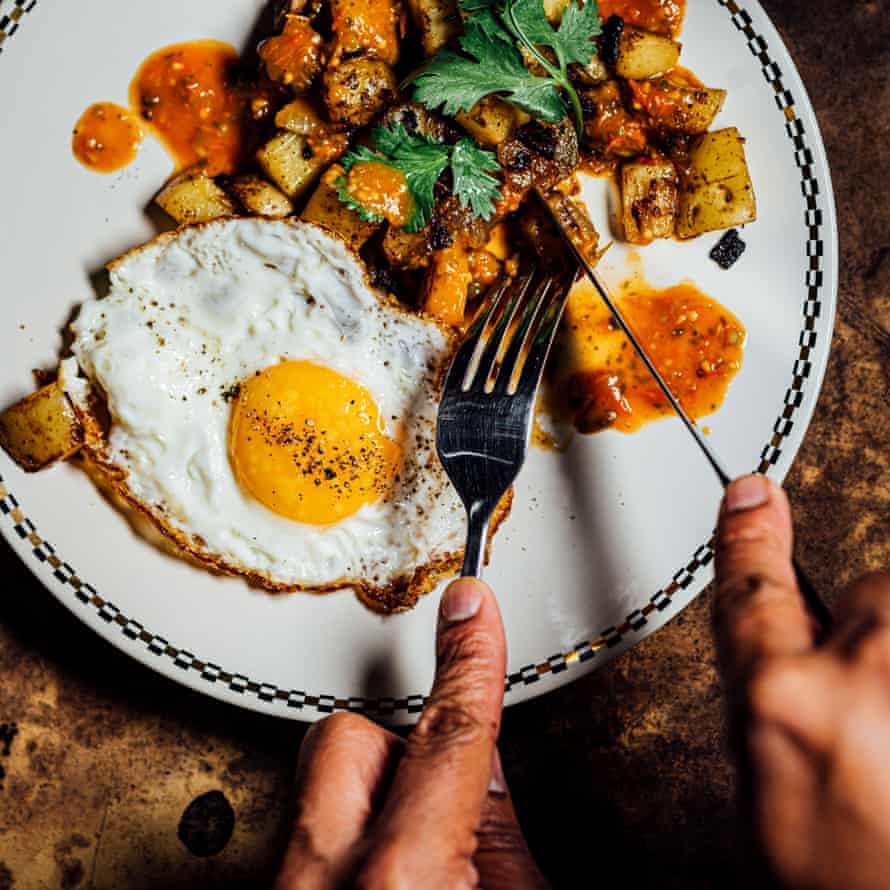
This works because it contains the proven mathematical combination of crunchy potatoes, fried eggs and a salty tomato sauce that seems to be appropriate for a lazy Sunday just before the long week starts to rear its head. The seared tomato green peppercorn ch
utney is something I think you might want to make in a large batch; it is quick to make and pairs well with many different types of savoury dishes – try it with roasted butternut or pumpkin slices. This chutney gets better with age.
-
I’ve built and layered heat in different ways into the different components of this dish. The warm spices in garam masala work in concert with the cayenne to create heat in the potatoes.
-
The acidity of amchur makes the heat even more prominent. For a tangier note, use more amchur.
-
The quality of your cherry tomatoes and the degree of charring will make the flavour of this chutney. Using a large frying pan provides a larger surface area for the tomatoes to cook and prevents overcrowding, helping the steam escape.
-
The tomato chutney gets a mild dose of heat from the brined green peppercorns; the fried eggs get theirs from black pepper.
-
Additionally, this dish is served warm, which intensifies the chemesthetic quality of these ingredients.
Serves 4 with 240ml of sauce
For the hash browns
ghee 3 tbsp
Yukon gold potatoes 455g, diced into 1cm cubes
yellow or white onion 1 medium (260g), diced
garam masala 2tsp
cayenne powder ¼ tsp
amchur 1½-2 tsp
fine sea salt or kala namak
fresh coriander leaves 2 tbsp, for garnish
For the chutney
cherry tomatoes 340g
extra virgin olive oil 1 tbsp
apple cider vinegar 1 tbsp
garlic 1 clove, peeled
brined green peppercorns 2 tbsp, crushed
fresh green chilli 1
fine sea salt
For the eggs
ghee 4 tbsp
eggs 4 large
fine sea salt or kala namak
coarsely ground black pepper
To prepare the hash browns, melt the 3 tablespoons of ghee in a large cast-iron or stainless-steel frying pan over medium- low heat. When the ghee is hot, add the potatoes and onion. Sprinkle on the garam masala and cayenne and season with salt. Cook until the potatoes are completely tender, turning them every 6 to 8 minutes until they are evenly browned, 25 to 30 minutes. Remove from the heat and season with the amchur. Taste and season with salt. Garnish with the fresh coriander.
While the hash browns cook, prepare the chutney. Heat a large, dry stainless-steel frying pan over high heat until smoking, 3 to 4 minutes. When the pan is hot, add the tomatoes and cook until they are seared and develop slight char marks all over and the skins start to split, 4 to 6 minutes. Transfer the tomatoes to the bowl of a blender or a food processor. Add the olive oil, apple cider vinegar, garlic, peppercorns and chilli and pulse for a few seconds until combined and the peppercorns are broken into bits. The sauce should be slightly chunky and not completely smooth. Taste and season with salt.
To prepare the eggs, heat the ghee in a small cast-iron or stainless-steel frying pan over medium-high heat, swirling to coat. Turn the heat to low. Crack an egg into a small bowl, tip it into the skillet, and cook until the egg white sets and the edges turn crispy, about 1½ minutes. Transfer the egg to a serving plate. (If you want the white to set on top of the yolk, cover the skillet while you cook the egg.) Repeat with the remaining eggs. Season with a little salt and pepper and serve immediately with the warm hash browns and the tomato green peppercorn chutney on the side.
Masala cheddar cornbread
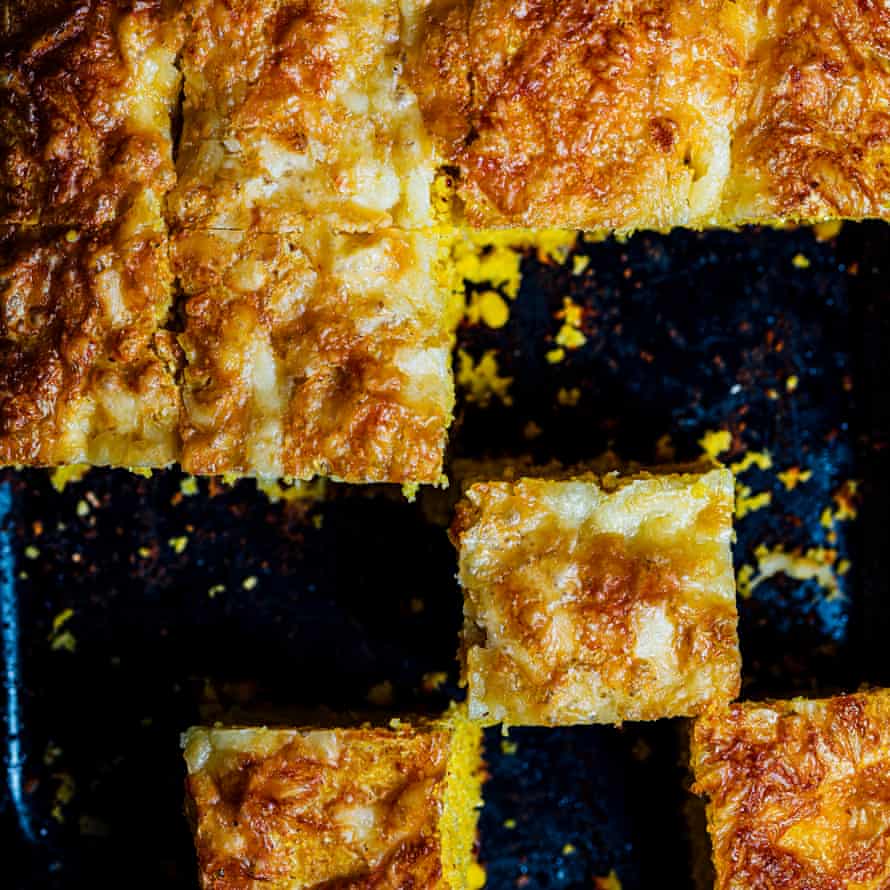
la cheddar cornbread. Photograph: Nik Sharma
I’m the type of person who adds extra cheese to pizza, so this cornbread is a tribute to my love for cheese. It’s a riot of flavour, with sharp cheddar, sweet, tiny nuggets of corn that burst in your mouth and a little fire from the red chilli flakes.
-
Adding sweetcorn kernels to the mixture of flour and cornmeal adds a depth of sweetness.
-
Dark brown sugar, jaggery and honey contribute sweetness as well as help with the structure of the bread as it bakes. They also participate in the caramelisation and Maillard reaction and introduce new flavour molecules.
-
Dairy fats, including ghee and cheddar, as well as the lipids in the yolks provide fat in the cornbread, which boosts texture, taste and aroma.
-
Turmeric’s chief role in this cornbread is as a pigment to increase the rich yellow.
-
Fennel seeds amplify the perception of sweetness.
Serves 4-6
ghee or unsalted butter 120ml, melted, plus a little extra to grease the baking dish
plain flour 280g
medium-grind cornmeal 280g
baking powder 1 tbsp
ground coriander 1 tsp
ground fennel 1 tsp
red chilli flakes 1-2 tsp, such as Aleppo or Maras
ground turmeric ½ tsp
ground cayenne ¼ tsp
sharp cheddar 200g, grated
sweetcorn kernels 145g, fresh or frozen (if frozen, thaw before use)
dark brown sugar or jaggery 50g
honey 85g
eggs 4 large, at room temperature
whole milk 480ml, at room temperature
fine sea salt 2 tsp
Preheat the oven to 180C fan/gas mark 6. Grease a 23cm x 30cm baking dish with a little ghee.
In a large bowl, whisk together the flour, cornmeal, baking powder, coriander, fennel, red chilli flakes, turmeric and cayenne. Reserve 3 tablespoons of the dry mixture.
Toss 100g of the cheddar and the corn kernels with the reserved 3 tablespoons of the dry mixture in a medium mixing bowl.
In a large bowl, whisk together the melted ghee, brown sugar, honey, eggs, milk and salt until combined and the sugar is completely dissolved.
Make a well in the centre of the dry ingredients in the large mixing bowl. Pour the liquid mixture into the well and whisk until the ingredients are completely combined and there are no visible flecks of the dry ingredients. Using a spatula, fold in the cheddar-corn mixture. Pour the mixture into the greased baking dish and level the surface with the spatula. Sprinkle the remaining 100g of cheddar over the surface. Bake until the sides are golden brown, and a skewer or knife comes out clean when inserted into the centre, 25 to 30 minutes. Serve warm.
Grilled hearts of romaine with chilli pumpkin seeds
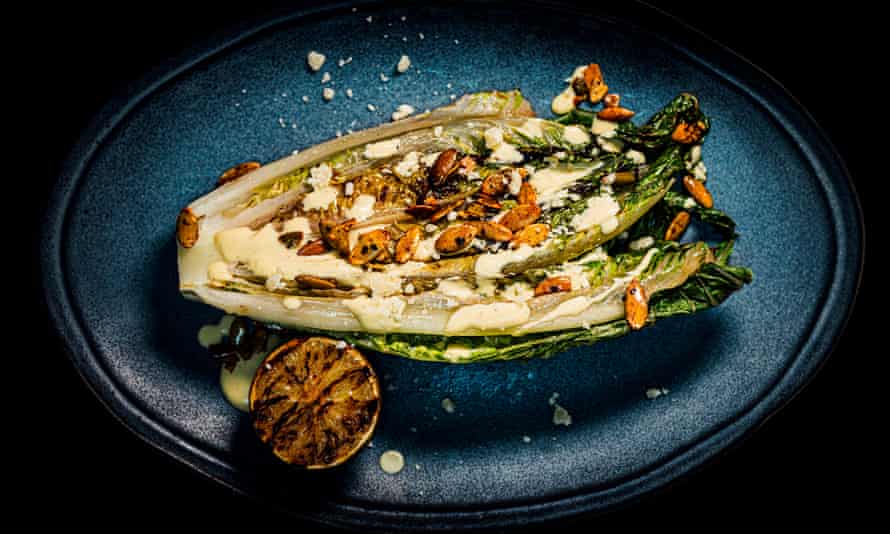
Romaine lettuce hearts take on a completely new flavour when grilled in this salad. I use a grilling pan, but you can most certainly make this on an outdoor grill.
-
Grilling the lettuce and lime adds depth via the caramelisation and Maillard reactions.
-
The lime juice and the lactic acid from the Greek yogurt offset the rich, creamy texture of fat and proteins.
-
Parmesan provides a hint of salty and savoury, due to its high free glutamate content.
-
Heat changes the mouthfeel of the lettuce; the leaves will turn a little soft, while the midrib retains its crunchiness.
Serves 4
For the chilli pumpkin seeds
raw pumpkin seeds 35g
extra virgin olive oil 1 tbsp
ground paprika ½ tsp
fine sea salt
red chilli flakes 1 tsp, such as Aleppo, Maras or Urfa
For the garlic yogurt dressing (makes 240 ml)
plain, full-fat Greek yogurt 180g
creme fraiche 60ml
pomegranate molasses 2 tbsp
fresh lime juice 2 tbsp
garlic 2 cloves, peeled and grated
ground turmeric ½ tsp
fine sea salt
extra virgin olive oil 2 tbsp, plus extra to brush the grates of the grill
romaine lettuce 2 hearts
lime 1, halvedparmesan 2 tbsp, shaved, for garnish (optional)
To prepare the seeds, heat a small frying pan over medium heat. In a small bowl, mix the pumpkin seeds, olive oil and paprika. Season with salt. Add the seeds to the hot pan and sauté until they start to turn golden brown, 1 to 1½ minutes. Remove from the heat, add the chilli flakes, toss to coat well and spread the seeds out on a plate to cool.
To prepare the dressing, combine the yogurt, creme fraiche, pomegranate molasses, lime juice, garlic and turmeric in a blender. Pulse for a few seconds until completely smooth.
Taste and season with salt. Heat a griddle pan over medium-high heat. Brush the pan with a little olive oil. Cut the lettuce in half lengthways and brush the surface of the lettuce and the lime halves with oil. Place the lettuce halves, cut-side down, on the hot pan until the lettuce develops nice char marks, then flip, 2 to 2½ minutes per side. Remove from the heat. Place the limes on the hot surface of the griddle pan and sear until they start to develop a few char marks from the grill, about 1 minute. Remove from the heat and season with salt.
To serve, place the lettuce on a large serving dish. Drizzle a few tablespoons of the garlic yogurt dressing over the lettuce. Sprinkle the pumpkin seeds and parmesan, if desired, on top. Place the grilled limes on the side along with the remaining dressing. Serve immediately. OFM
Roasted fruit with coffee miso tahini

This combination of coffee and miso with tahini might seem a bit unusual, but stick with me; it works, creating a somewhat butterscotch-like taste. I prefer fruit-based desserts. No matter when you make them and how many times you repeat them, fruit always tastes different depending on variety, ripeness and provenance. This dessert is a good choice for a light and sweet finish to a heavy meal. Use it as a topping over vanilla or cardamom ice-cream or over a bowl of lightly sweetened Greek yogurt. To add a bit of a kick, fold in a few tablespoons of crystallised ginger. A little bit of this dressi
ng goes a long way. Serve it on the side.
-
White or shiro miso provides a welcome salty and savoury character to the bitter taste of coffee and tahini. This combination works well with fruit and dishes that are sweet with a bold sour character.
-
Roasting the fruit in their juices helps introduce a bunch of new flavour molecules via the caramelisation and Maillard reactions.
-
Unlike red cabbage, which loses its bright anthocyanin colours on heating, blueberries retain their colour. One reason is the presence of blueberry pectin, which is used in the food industry as a stabiliser for anthocyanins. Blueberry pectin can bind some types of anthocyanins and form a complex that is stable in the presence of heat and even acidic pH.
Serves 4
For the roasted fruit
unsalted butter 2 tbsp , plus extra for greasing
blueberries 340g, fresh or frozen (no need to thaw if using frozen)
fresh figs 340g, sliced in half lengthways
fresh lime juice 2 tbsp
maple syrup 2 tbsp
ground black pepper ½ tsp
fine sea salt ¼ tsp
For the coffee miso tahini (makes 180ml)
shiro or sweet white miso 2 tbsp
maple syrup or honey 85g
tahini 55g
instant espresso or coffee powder ¼ tsp
fine sea salt
To prepare the fruit, preheat the oven to 170C fan/gas mark 5.
Grease a rectangular 20cm x 25 cm baking dish with a little butter and place it on a baking sheet lined with parchment paper to catch any of the juices that might bubble over. Place the blueberries and figs in a medium mixing bowl. Drizzle the lime juice and maple syrup over the fruit. Add the black pepper and salt and toss to coat well. Transfer the fruit with the liquids to the baking dish and spread in an even layer. Dot the fruit with the butter and roast until the figs start to caramelise and the fruits release their juices, 25 to 30 minutes. Remove from the oven.
While the fruit is roasting, prepare the coffee miso tahini. Whisk the miso, maple syrup, tahini, 60ml of water and the espresso powder in a small bowl until smooth. Taste and season with salt.
To serve, drizzle a few tablespoons of the sauce over the warm fruit and serve the rest on the side.
From The Flavor Equation: The Science of Great Cooking Explained (Chronicle Books, £26)
